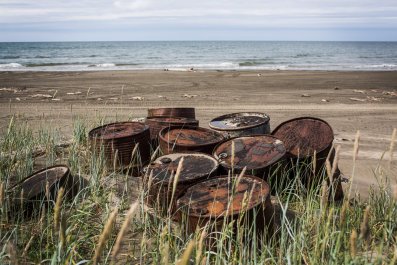In America, it's virtually impossible to avoid flame retardants. The chemicals are so ubiquitous that babies are born with it in their blood. Pick up a cushion from your sofa; if it's like more than half the couches in the country, as much as 30 percent of its weight is made up of flame-retardant chemicals.
Flame retardants are also all over car seats, mattresses, cribs, high chairs, strollers and just about anything else with foam upholstery. A Duke University study in 2014 found flame retardants in the blood of every child it tested, and American women's breast milk contains 75 times the level of flame retardant of that found in studies of women in Europe, where some of the chemicals are banned. Exposure has been linked to health problems ranging from cancer to preterm birth, as well as lower IQ and attention problems in children. Women with higher levels of flame retardant in their blood take longer to get pregnant, and animal studies have linked the chemicals to lower fertility in men.
The U.S. does not regulate flame retardants' use, though the Environmental Protection Agency (EPA) is considering it. Of course, the retardants are useful; if your mattress catches fire, these chemicals make it burn slower, potentially giving you time to escape. But as evidence of the retardants' health effects mount, questions arise about whether the risks outweigh the benefits.
What if, instead of choosing between fire safety or health, you could have both? In September, researchers at the University of Texas at Austin (UT) published their discovery of a flame retardant that is nontoxic and won't accumulate over time in the bodies of people who come in contact with it. It's made entirely from the chemical dopamine—the neurotransmitter in our brains associated with reward and pleasure. The researchers took their cue from marine mussels, who secrete a mucus-like "glue" made of dopamine that allows them to stick to nearly any surface, including Teflon, widely considered nonadhesive. The mussel's "glue" has been the focus of several studies, especially for its use as a bioadhesive; it's nontoxic, making it attractive for uses in the body, like closing incisions without stitches.
Christopher Ellison, associate professor in the Cockrell School of Engineering at UT, and his team found that the dopamine-based coating performs wonderfully as a fire retardant. In fact, according to the team's paper, the dopamine retardant reduces a fire's intensity 20 percent better than retardants on the market. "We beat them all," Ellison says.
The dopamine flame retardant is simple to make, and dopamine, synthesized in labs to treat a variety of diseases, is already widely available. "We put dopamine into a beaker of water, change the pH slightly and the dopamine units make longer chain structures spontaneously," forming a "polydopamine" that immediately bonds strongly to foam, Ellison says. In other words, all you need to do is drop the foam in water, add dopamine and slightly raise the pH level using a product similar to salt. "Nothing has to change about the manufacturing process of foam," says Ellison.
The polydopamine bonds so well to foam that it won't leach out, unlike conventional flame retardants that release into the environment easily. Ellison has a young child and says being a parent drove his research. "These are toys that they're putting in their mouths, things that they are sleeping on."
Now, he says, his team will try to tweak the process to see if there's a way to apply the nontoxic flame retardant more quickly. Right now, it requires days of soaking the foam, but he thinks it will be possible to get it down to just hours. He hopes the product will be available in three to five years. As momentum grows in statehouses across the country, and within the EPA, to act on the mounting evidence that conventional flame retardants might do more harm than good, the mussel-inspired alternative might be available right on time.

















